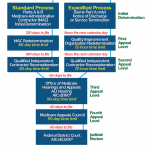According to the Final Rule, overpayments are subject to a six-year look-back period. This means that overpayments must be reported and returned if they have been identified within six years of the date the overpayment was received. Note: the six-year look-back period is not retroactive and went into effect on March 14, 2016.
Reporting & Return Process
Providers must use the reporting process established by the applicable Medicare Administrative Contractor (MAC) to report the overpayment. This may include applicable claims adjustment, credit balance, self-reported refund or other processes set forth by the individual MACs. It is important that if the amount of the overpayment was calculated using a statistical sampling methodology, then the provider must describe the statistically valid sampling and extrapolation methodology in the report.
Keep in mind, CMS has included a provision for overpayments to be suspended if a provider submits a request for an extension to repay any overpayment(s) to their MAC. The deadline will remain suspended until CMS or the MAC rejects the suspended repayment schedule request or the provider fails to comply with the terms of the extended repayment schedule.
Effective Date
Although the final rule was released and went into on effect on March 14, 2016, providers have been subject to the Affordable Care Act’s provisions for timely reporting and returning of Medicare overpayments since March 23, 2010.
CMS states that provisions of the final rule are not retroactive. Providers who reported and/or returned overpayments prior to March 14, 2016, and who made a good faith effort to comply with the Affordable Care Act’s “report and return” requirements, are not expected by CMS to have complied with each provision of the final rule. All providers reporting and returning overpayments on or after March 14, 2016—even overpayments received prior to this date—must comply with the requirements of the final rule.
Implementation for Practices
Although healthcare providers have long been obligated to report and return overpayments, providers should now take key steps to prepare their practice in response to the final rule.
Step 1: Providers should implement or review processes to ensure they respond appropriately regarding a potential overpayment that has credible information. Credible information may include the finding of a single, overpaid claim (which may trigger the need for additional review of charts).
Step 2: Watch for one or more hotline complaints regarding the same or similar payment-related issue and work on identifying any claims that may fall within those complaints
